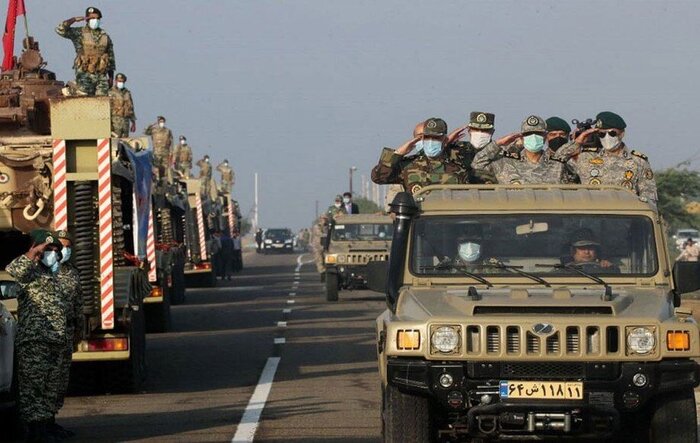Spokesman for the Zolfaqar-1400 Army Joint Exercise Rear Admiral Mahmoud Mousavi noted on Tuesday that the equipment displayed at the final parade of the Zolfaqar-1400 drills is part of Iranian military hardware applied by different units in southern port of Makran.
The military exercises consist of different series and scenarios in an operational area of more than one million square meters, the spokesman said.
Upgrading combat capabilities, defending independence and territorial integrity of the Islamic Republic of Iran, as well as enhancing effective presence in distant international waters, improving readiness of armed forces to stand against foes' provocations, simulating real combat ground, increasing coordination amongst four sections of Iran's Army, conveying experiences to young generation, and utilizing the Army's current drone capacities were among the objectives of the drills, Mousavi argued.
Holding such military drills improves might of ground, maritime, and air forces to add to the power of operating forces in the face of enemies, he added.
The organizers of the military exercises also wanted to bolster deterrence capability of the Iranian Armed Forces in facing future threats as well as to increase self-reliance and self-confidence in identifying potential dangers based on nationalized and home-made technologies, he mentioned.
Abdolrahim Mousavi, the commander-in-chief of the Iranian Army, and some other commanders inspected the final stage of the Zolfaqar-1400 drills.
The final parade included various naval surface vessels and submarines, including home-made Dena Destroyer, Tareq and Qadir submarines, and guided missile destroyers as well as F4 and Mirage warplanes, reconnaissance aircraft P3F and helicopters.
Brigadier General Nozar Nemati, the deputy commander of the Army Ground Forces, said on Monday that the Army fired smart artillery shells for the first time during the Zolfaqar-1400 drills.
Different sections of the Iranian Army took part in the military exercise, which is unique in terms of planning of operation scene and implementation by every rank and equipment, Nemati noted.
In order to target mock enemies from a long distance, the army forces utilized drones and missiles backed by helicopters, he added.
The military officials went on to say that all 28 branches of the ground forces have been involved in the operation, using renovated armored personnel carrier, saying that Arash suicide and combat drone was showcased in the event.
The drills convey a clear message to enemies that they should not think of any kind of aggression against the Islamic country, Nemati said.
The full scale war game in the Strait of Hormuz, the Sea of Oman, and northern parts of the Indian Ocean engaged the Iranian Army's navy, air force, air defense and ground force from November 7-9.
Deputy Commander of Iranian Army Air Defense Brigadier General Ali-Reza Elhami said that the domestically-developed 15-Khordad and Mersad air defense systems used in the Zolfaqar-1400 joint drills proved Iran's power, knowledge, and authority.
Referring to the wide participation of the Iranian Army's drones in the drills, Elhami said that various types of short- and long-range drones flew with different missions, including reconnaissance and intelligence, as well as systems evaluation and combat.
The drills' spokesman Mahmood Mousavi said domestically-developed drones first monitored enemies' positions and then targeted them.
1424
Follow us on Twitter @IrnaEnglish
